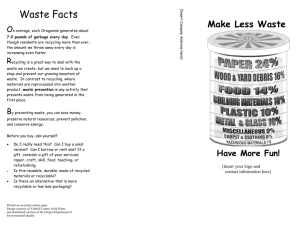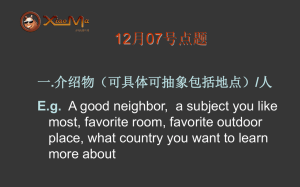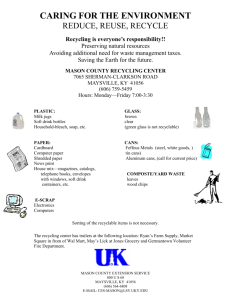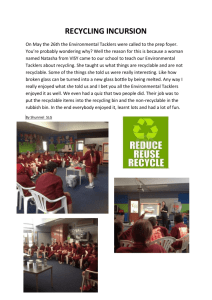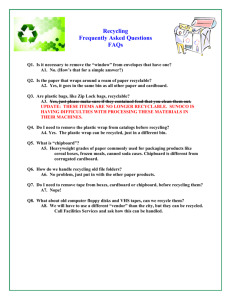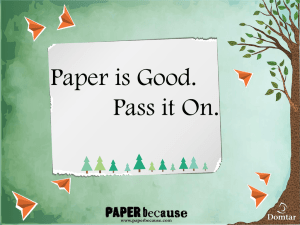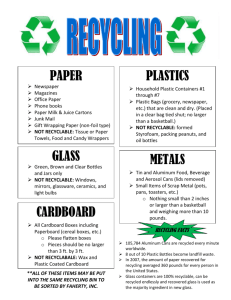TAKING ACTION ON RECYCLING This curriculum outline helps
advertisement
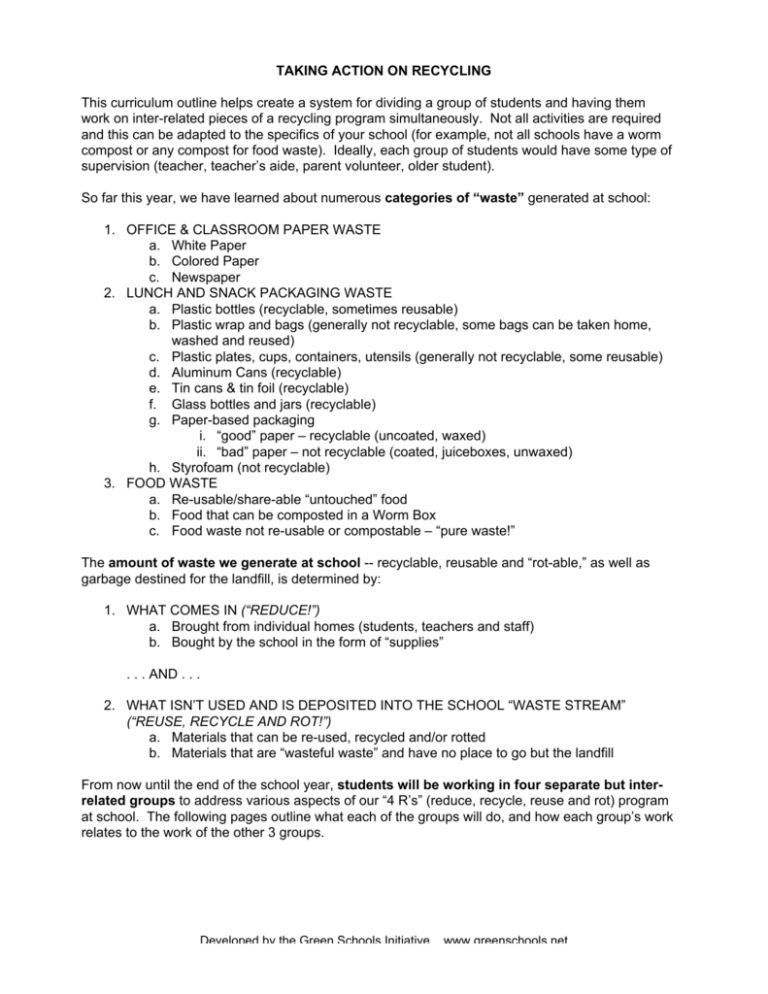
TAKING ACTION ON RECYCLING This curriculum outline helps create a system for dividing a group of students and having them work on inter-related pieces of a recycling program simultaneously. Not all activities are required and this can be adapted to the specifics of your school (for example, not all schools have a worm compost or any compost for food waste). Ideally, each group of students would have some type of supervision (teacher, teacher’s aide, parent volunteer, older student). So far this year, we have learned about numerous categories of “waste” generated at school: 1. OFFICE & CLASSROOM PAPER WASTE a. White Paper b. Colored Paper c. Newspaper 2. LUNCH AND SNACK PACKAGING WASTE a. Plastic bottles (recyclable, sometimes reusable) b. Plastic wrap and bags (generally not recyclable, some bags can be taken home, washed and reused) c. Plastic plates, cups, containers, utensils (generally not recyclable, some reusable) d. Aluminum Cans (recyclable) e. Tin cans & tin foil (recyclable) f. Glass bottles and jars (recyclable) g. Paper-based packaging i. “good” paper – recyclable (uncoated, waxed) ii. “bad” paper – not recyclable (coated, juiceboxes, unwaxed) h. Styrofoam (not recyclable) 3. FOOD WASTE a. Re-usable/share-able “untouched” food b. Food that can be composted in a Worm Box c. Food waste not re-usable or compostable – “pure waste!” The amount of waste we generate at school -- recyclable, reusable and “rot-able,” as well as garbage destined for the landfill, is determined by: 1. WHAT COMES IN (“REDUCE!”) a. Brought from individual homes (students, teachers and staff) b. Bought by the school in the form of “supplies” . . . AND . . . 2. WHAT ISN’T USED AND IS DEPOSITED INTO THE SCHOOL “WASTE STREAM” (“REUSE, RECYCLE AND ROT!”) a. Materials that can be re-used, recycled and/or rotted b. Materials that are “wasteful waste” and have no place to go but the landfill From now until the end of the school year, students will be working in four separate but interrelated groups to address various aspects of our “4 R’s” (reduce, recycle, reuse and rot) program at school. The following pages outline what each of the groups will do, and how each group’s work relates to the work of the other 3 groups. Developed by the Green Schools Initiative _ www.greenschools.net 4 GROUPS OF STUDENTS WORKING ON THE “4-R’S” AT SCHOOL 1. RECYCLING RAVERS a. Organize the comprehensive SYSTEMS and LOGISTICS required to effectively collect and sort waste into all of the necessary categories to support our school’s recycling, re-use and rotting efforts. Coordinate with the FOOD WASTE FIGHTERS to learn how, where and when they would like to see re-usable and rot-able food collected; and on a system for monitors or “checkers.” This could involve creating a map for where all garbage cans, recycling containers, and worm food buckets go. b. Obtain and/or create the MATERIALS and SIGNAGE necessary to put the systems into effect, and put them into effect! (The FOOD WASTE FIGHTERS will create the signage for the rot-able and re-usable food collection bins – coordinate with them). c. Create written and graphic informational materials and/or posters to explain to school groups (students, teachers and staff) on a general/ comprehensive level how the “4 Rs” program will work, and to encourage participation. 2. 4-RS CAMPAIGNERS a. Design, organize and present/perform one or several EDUCATIONAL SESSIONS, PROGRAMS AND/OR PERFORMANCES to teach children, teachers and staff about the 4Rs program at school. b. Work closely with all other groups to make sure information they deem important is included in your group’s work. 3. WASTE-FREE LUNCHERS (Address potential lunch waste coming IN) a. Design, create and then implement a program to EDUCATE PARENTS, KIDS, TEACHERS AND STAFF ON HOW TO PACK WASTE-FREE LUNCHES that include i. Food that will be eaten, in appropriate quantities (to reduce food waste), and ii. Packaging that can be re-used, recycled or composted (to reduce the amount of items that end up as “wasteful waste”) b. Work with RECYCLING RAVERS and 4R CAMPAIGNERS to make sure they are knowledgeable about the programs you create, and they include information you deem important in their materials and presentations. c. Create written and/or graphic informational materials to explain to parents, students, teachers and staff how to pack waste-free lunches. Check with the Recycling Ravers to coordinate your “Waste Free Lunch” materials with the more general “4Rs” materials they are creating. 4. FOOD WASTE FIGHTERS (Address food waste going OUT) a. Create, organize and implement a system for collecting food waste to re-use/share (i.e. untouched food) and food waste to compost in a worm bin that effectively gathers only appropriate items and excludes inappropriate items. Create appropriate signage and/or information sheets. Organize monitors or “checkers”, if deemed necessary. b. Create, organize and implement a system for maintaining the health and effectiveness of the worm bin, and for harvesting compost. This will require a schedule for feeding the worms and maintaining the paper. c. Create, organize and implement a system for collecting and “stripping” newspaper for the worm bin. d. Create, organize and implement a system for sharing un-eaten, re-usable food with the school and/or other communities. e. Work with RECYCLING RAVERS and 4R CAMPAIGNERS to make sure they are knowledgeable about the systems you devise, and include information you deem important in their materials and presentations. Developed by the Green Schools Initiative _ www.greenschools.net
